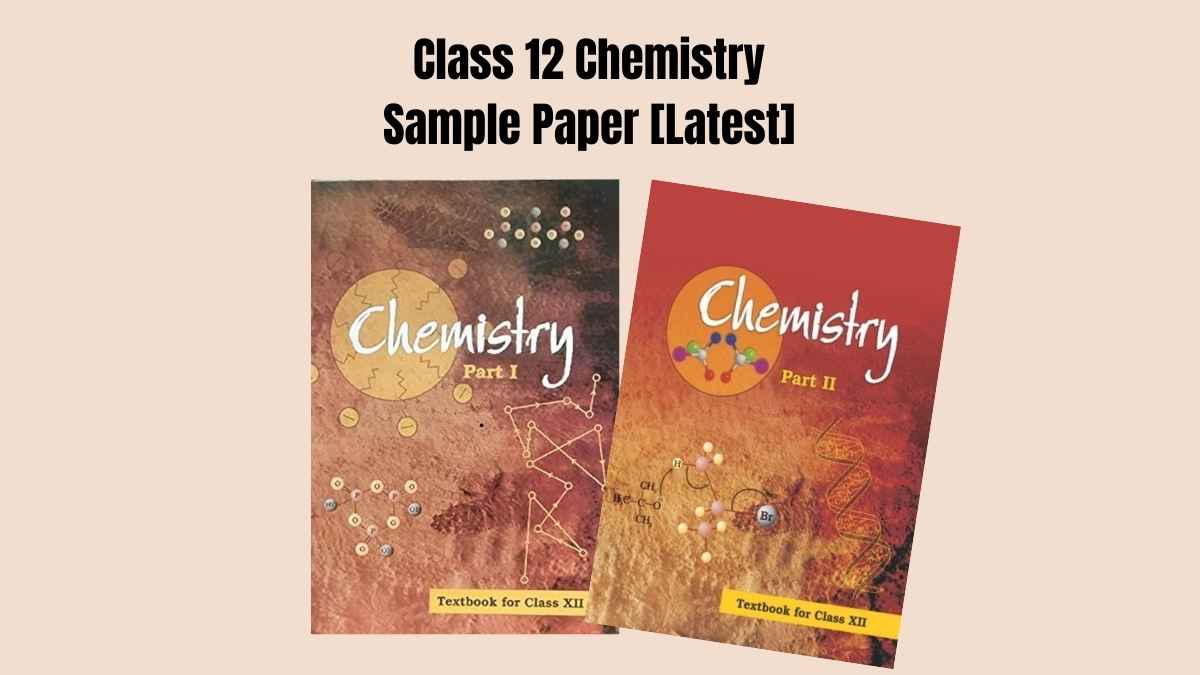Table of Contents
The Chemistry subject sample paper has been released by the CBSE Board at its official website to ensure that the students who are to appear for the final exams to be held in February/March 2025 can complete their preparations using them. Sample papers play a very big and important role in a student’s life as they help them prepare for the exam by crafting an exam-like scenario, exam-like questions, etc.
Therefore, the CBSE Board has finally released the CBSE Class 12 Chemistry Sample Paper 2024-25 with solutions at its official website, i.e., https://www.cbse.gov.in/. The direct link to download the sample papers has been added to the article below.
CBSE Class 12 Chemistry Sample Paper 2024-25
The CBSE Class 12 Chemistry Sample Paper 2024-25 is live on the official website and all the students who are studying in class 12th need online to visit the CBSE portal at https://www.cbse.gov.in/ to collect the sample papers along with their solutions. The Chemistry sample papers have been designed by the board officials in a manner to replicate the final question paper, this will help students analyze and understand the type of questions to appear in the final exam, ratio of questions from each topic, the importance of topics, etc. Practicing using CBSE Class 12 Sample Papers 2025 will help students better understand their strengths and weaknesses in various topics.
CBSE Class 12 Chemistry Exam Pattern 2025
The CBSE Class 12 Chemistry exam has 33 questions divided into different sections. Section A has 16 multiple-choice questions, each worth 1 mark. Section B has 5 very short answer questions, each worth 2 marks. Section C has 7 questions, Section D has 2 questions, and Section E has 3 questions. The total marks for the exam are distributed across these sections, with each section having different types of questions and mark values. This format helps test students’ understanding in various ways.
| CBSE Class 12 Chemistry Exam Pattern 2025 | |||
| Sections | Category | No. of Questions | Marks |
| Section A | Multiple Choice Questions (MCQs) | 16 | 1 mark each |
| Section B | Very Short Answers (VSA) | 5 | 2 marks each |
| Section C | Short Answers (SA) | 7 | 3 marks each |
| Section D | Long Answers (LA) | 2 | 5 marks each |
| Section E | Source-based/ Case-based/ Passage based/ Integrated units of assessment | 3 | 4 marks each |
CBSE Class 12 Chemistry Sample Paper 2024-25 PDF with Solutions
Sample papers are a helpful resource for students preparing for exams. We have provided a direct link to access the CBSE Class 12 Chemistry Sample Paper for 2024-25, along with solutions, in the table below. By solving this sample paper, students can improve their understanding of the subject and enhance their skills for the chemistry exam. It’s a great way to practice and get ready for the test.
| CBSE Class 12 Chemistry Sample Paper 2024-25 | ||
| Subject | Sample Question Paper (SQP) | Marking Scheme (MS) |
| Chemistry | CBSE Class 12 Chemistry Sample Paper PDF | Click Here |
Download Class 12 Chemistry Sample Paper PDF with Solutions (Previous Year)
Practicing with previous year’s sample papers helps students understand the types of questions asked regularly. It allows them to identify important and less important topics. The table below provides direct links to download the Class 12 Chemistry Sample Papers along with Solutions. By clicking on the links, students can easily access the sample papers and the marking scheme to practice and prepare better for their exams.
| CBSE Class 12 Chemistry Sample Paper 2024-25 | |||
| Year | Subject | Sample Question Paper (SQP) | Marking Scheme (MS) |
| 2023 | Chemistry | Click Here | Click Here |
| 2022 | Chemistry | Click Here | Click Here |
| 2021 | Chemistry (Term 1) | Click Here | Click Here |
| Chemistry (Term 2) | Click Here | Click Here | |
CBSE Class 12 Chemistry Sample Questions 2024-25
Section – A
Q1. The major product of acid catalysed dehydration of 1-methylcyclohexanol is:
a. 1-methylcyclohexane
b. 1-methylcyclohexene
c. 1-cyclohexylmethanol
d. 1-methylenecyclohexane
Ans. b. 1-methylcyclohexene
According to Saytzeff rule i.e highly substituted alkene is major product. Here dehydration reaction takes place, alkene is formed due to the removal of a water molecule.
Q2. Which one of the following compounds is more reactive towards SN1 reaction?
a. CH2=CHCH2Br
b. C6H5CH2Br
c. C6H5CH (C6H5)Br
d. C6H5CH(CH3) Br
Ans. c C6H5CH (C6H5)Br
C6H5CH (C6H5)+ carbocation formed is more stable
Q3. KMnO4 is coloured due to:
a. d-d transitions
b. charge transfer from ligand to metal
c. unpaired electrons in d orbital of Mn
d. charge transfer from metal to ligand
Ans. b. charge transfer from ligand to metal
The Mn atom in KMnO4 has +7 oxidation state with electron configuration [Ar]3d 04s0 Since no unpaired electrons are present, d−d transitions are not possible. The molecule should, therefore, be colourless. Its intense purple due to L→M (ligand to metal) charge transfer 2p(L) of O to 3d(M) of Mn.
Q4. Which radioactive isotope would have the longer half-life 15O or 19O? (Given rate constants for 15O and 19O are 5.63x 10-3 s -1 and k = 2.38 x 10-2s-1 respectively.)
a. 15O
b. 19O
c. Both will have the same half-life
d. None of the above, information given is insufficient
Ans. a. 15O
The rate constant for the decay of O-15 is less than that for O-19. Therefore, the rate of decay of O-15 will be slower and will have a longer half-life.
Q5. The molar conductivity of CH3COOH at infinite dilution is 390 Scm²/mol. Using the graph and given information, the molar conductivity of CH3COOK will be:
a. 100 Scm²/mol
b. 115 Scm²/mol
c. 150 Scm²/mol
d. 125 Scm²/mol
Ans. b. 115 Scm²/mol
ΛoCH3COOK = Λo CH3COOH +ΛoKCl – ΛoHCl = 390 +150-425 = 115 Scm²/mol
Q6. For the reaction, A +2B AB2, the order w.r.t. reactant A is 2 and w.r.t. reactant B. What will be change in rate of reaction if the concentration of A is doubled and B is halved?
a. increases four times
b. decreases four times
c. increases two times
d. no change
Ans. a. increases 4 times
Rate = [A]2
If [A] is doubled then Rate’ = [2A]2 = 4 [A]2 = 4 Rate.





 Class 12 Informatics Practices CBSE Samp...
Class 12 Informatics Practices CBSE Samp...
 CBSE Class 12 Computer Science Sample Pa...
CBSE Class 12 Computer Science Sample Pa...
 CBSE Class 12 Accountancy Sample Paper 2...
CBSE Class 12 Accountancy Sample Paper 2...









